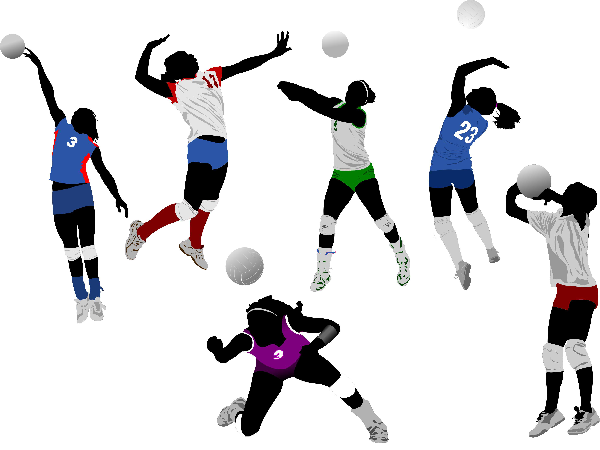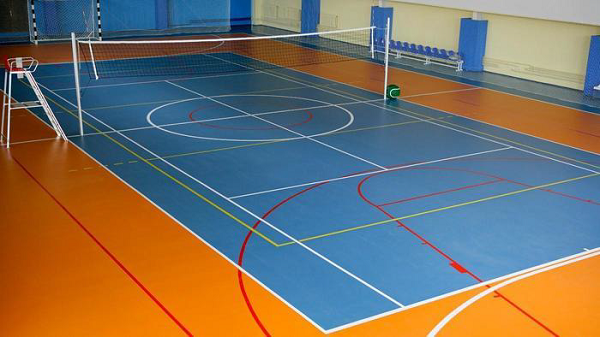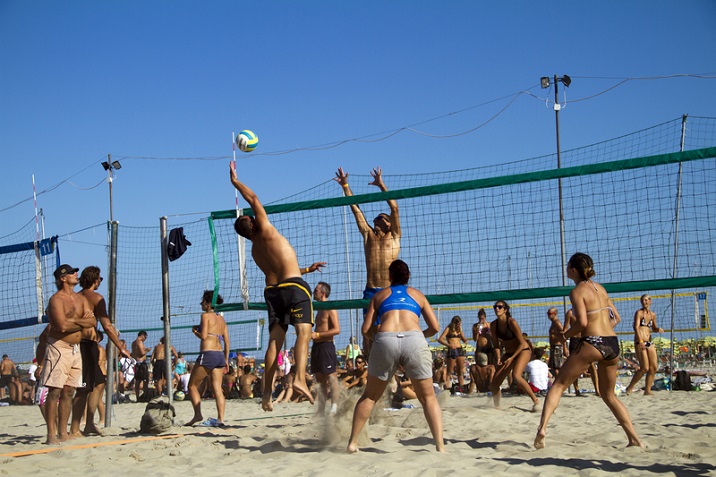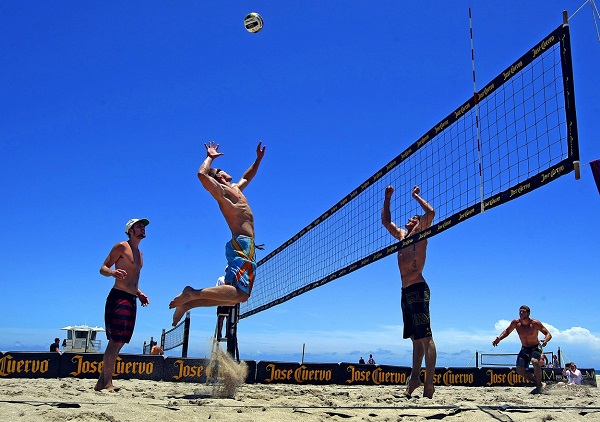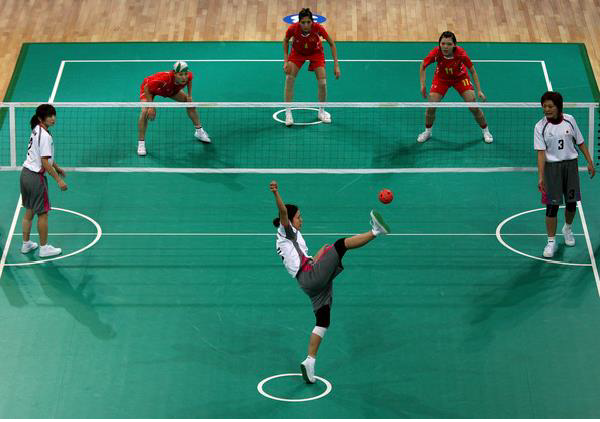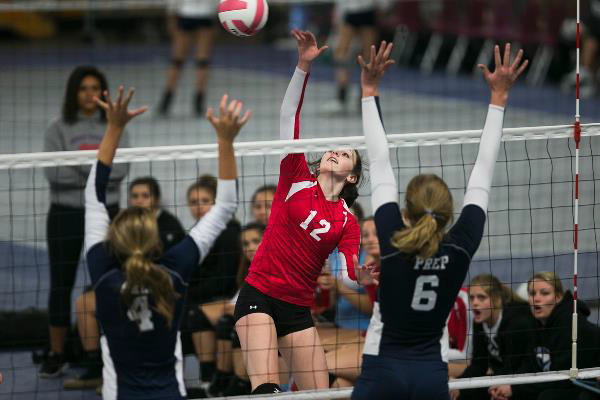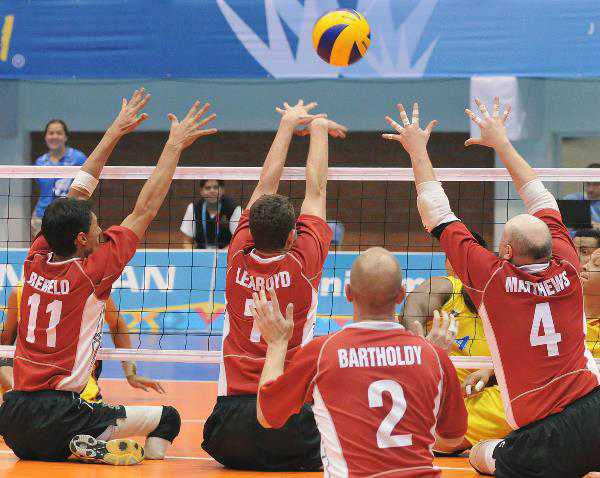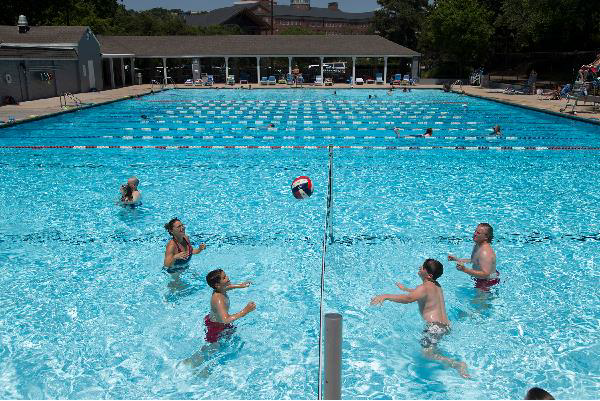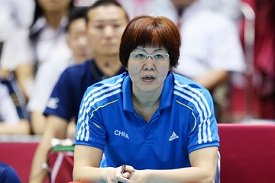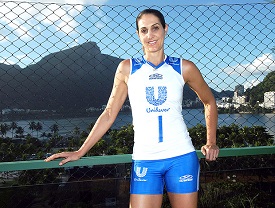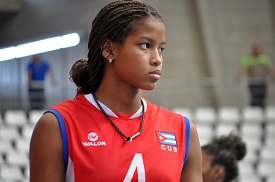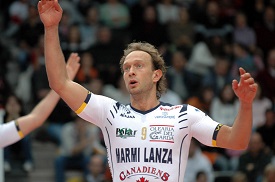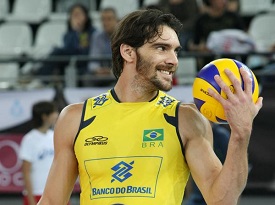Volleyball – Overview
Volleyball originated in the United States at a YMCA club in Holyoke in 1895 as Mintonette. It was invented by William G. Morgan, a physical director of the YMCA club. He wanted to invent a not-so-strenuous indoor game that businessmen in the club can play. Players strike the ball and it volleys among the players, so it was later named Volleyball by a professor from Springfield College in Massachusetts.
Volleyball quickly gained popularity among various YMCA branches in the States and it was subsequently spread to other parts of the world during the World War I by the American troops. Since it is not a very vigorous sport, women also took interest in the sport and started playing Volleyball.
Volleyball is played by two teams in a rectangular court, divided into two equal halves across the length by a net tightly stretched between two poles fixed at either side of the court. It is one of the most popular rally games and is today widely played across the world.
The objective of the game is to try to make the ball touch the ground on the opponent side. When the ball is hit by a team, the members of other team hit it with their hands to prevent it from touching the ground and to send it to another teammate or to the other side of the court across the net. Only three players from the team can strike the ball successively before they send it to the other team.
Volleyball allows players to pass the ball among teammates like basketball, but the strategies of defending and attacking are similar to other net or racquet games. Players try to shoot the ball over the net at the opponent side where it is tough for the opponents to volley it. The players of both teams have to prevent ball from touching the ground thus preventing the opponent to gain points.
Team Size
Volleyball is played among two teams of six players each. A team may also have six more substitute players. One of the players is the team captain and one of them is Libero. Players are positioned in two rows of three players each. The Libero is identified with a dress different from other team members. He is a specialist in defending and cannot serve or move to the frontcourt.
The team captain along with the coach is responsible for maintaining discipline in the team. The team captain also represents the team and speaks about their team members concerns.
During a competition, each team has a coach, one or two assistant coaches, a physiotherapist, and a doctor. These members sit along with substitute players on their team bench outside free zone.
Participating Countries
As volleyball originated in the United States, it is very popular there. The game has spread to other surrounding countries and Europe. The game is simple, quick, entertaining and does not require much equipment.
Many times in world championships, a new team surprisingly emerges as a top contender and proves that good coaching facilities and good practice can make good players.
Russians and the former Soviet teams won many Olympics and world championships. The game is also widely played in China, Japan, and Korea. Some other countries that take part in this game are Brazil, Mexico, Canada, Cuba, United States, Australia, New Zealand, Philippines, and Argentina.
Regulating Bodies
Fédération Internationale de Volleyball (FIVB) is the international regulating body of volleyball. It governs rules, appoints referees for international tournaments and conducts world cups and world championships for both men and women. It was formed in Paris and the current headquarters is at Mexico.
FIVB is the official governing body responsible for conducting various tournaments and promoting volleyball and beach volleyball. About 220 national volleyball organizations are members of FIVB. Many of these federations organize volleyball championships and the winners take part in international events.
Volleyball – Playing Environment
Volleyball is played in a rectangular court, divided into two equal halves across the length by a net tightly stretched between two poles, fixed at either side of the court.
Court Design
A standard international volleyball court is an indoor, rectangular in shape whose sides are 18 meters and the ends are 9 meters. The surface of the court is neither slippery nor rough, to avoid injuries. International courts have wooden or synthetic flooring.
The court is divided into two similar squares of 9 X 9 meters by a center line, one for each team. The court is further divided into the following zones −
Free zone − The playing surface is surrounded by a free zone up to 3 meters on all sides. The free zone in international courts is 5 m from the longer sides and 8 meters from the shorter sides.
Front zone − The front zone in each half extends from the center line to the attack line. It is drawn 3 meters away from the center line on both sides of the court.
Service zone − This zone is used for servicing the ball to the opponent court behind the end lines and has a width of 9 meters. The player has to be in the service zone while jumping or serving.
Substitution zone − The substitution zone lies between the scorer’s table and the attack line.
Libero replacement zone − The Libero replacement zone is a part of the free zone beside team benches and between the extended attack line and the end line.
Volleyball – Equipment
Volleyball is a simple game which doesn’t require any equipment other than a ball, a net and a flat court. Even two players can play and have fun with volleyball.
Net
Net is one meter long and 9.5 to 10 meter wide. It is tied vertically above the center line of the court to posts fixed at either side of the court, at a distance of one meter from the sidelines. The center of the net should lie 2.43 meter above the ground for men and 2.24 meter for women. At the sides, the net may be higher by a maximum of 2cm, however it should be tied at the same height at both the posts.
The court width is marked on the net with a tape and a flexible antenna of one meter extends from the tape marker on both sides of the net. These markings help the referee determine when the ball goes outside the court.
Ball
Volleyball a spherical ball of 65-67 cm circumference. It is made of leather or any synthetic material and weighs 260-280 g.
Volleyballs are available in various colors, however, for international tournaments, FIVB approved balls should only be used.
Other Equipment
Players of a team are uniformly dressed in jerseys, shorts, socks and sports shoes. Jerseys of each team have a different color.
Volleyball – Common Terms
- Rally − A ball is serviced by a player and players of both teams hit it till a foul is committed or ball falls on the ground. This period, from the point it is put to service till it halts is called a rally. It is a complete rally if one of the teams scores a point.
- Service − Players hit the ball with their fist, wrist, or arm, from the service zone and it has to move above the net to the other teams play zone.
- Warm up sessions − Players can get used to the environment and practice in a short six to ten minute warm-up sessions before the actual game begins.
- Attack hit − The hit that sends the ball to the opponent side.
- Positional Fault − Players are numbered in anti-clockwise starting from the player in extreme right position in the back row. So, players in the front row are numbered 4, 3 and 2 and players in the back row are numbered 5, 6 and 1 from left to right. They should lie in the same positions declared before beginning a set, when a ball is served, else they earn a fault. However, after the service, they may move within their court.
- Rotational Fault − If a receiving team earns a chance to serve, its players change positions and move clockwise, i.e. player in 1st position moves to 6th player in 2nd position moves to 1st, etc. Not changing positions according to this order leads to a fault. An exception to this rule is the Libero who cannot serve or enter the frontcourt.
- Four-Hit Foul − Three players in the receiving team may hit the ball consecutively and the fourth hit should deliver the ball to the other side, failing so will earn them a four-hit fault.
- Double Contact − Players should hit the ball to a teammate or to the other team. Simultaneous hitting leads to a fault.
- Assisted Hit − Players shouldn’t receive help from their teammates or any other objects like posts to hit the ball.
- Serving Fault − Players should serve according to the serving order. They should hit the ball according to the rules and when instructed. Not complying with these rules leads to a serving fault.
- Double fault − If opponents commit faults successively, they have to play the rally again. This scenario is called a Double Fault
- Blocking − Players near the net may jump and hit the ball near the net after an attack hit. Sometimes the ball doesn’t even completely cross the net. This action is referred to as blocking.
- Crossing space − The gap or space between the antennae and above the net is termed as Crossing Space. This space can also extend to the roofs inside the indoor courts. The ball should cross the net only through the crossing space.
Volleyball – How to Play
Before the tournament starts, coaches of both the teams handover the player’s list and their corresponding positions to the referee.
Getting Ready
Both the teams participate in a warm-up session of six to ten minutes. All the players should be ready and should comply with the rules and obey the decisions of the referee. Substitute players should also be ready and should join the team when the referee allows them.
The other non-playing team members and substitute players take their positions in the team bench. The match starts with the referee tossing a coin in the presence of team captains of both the teams. The team that wins the toss chooses between serving the ball and in receiving the service. It also chooses which side of the court it will play.
Quick Glimpse of the Game
Here’s how the ball moves among the players in a volleyball rally.
One player is positioned extreme right in the back line of the team that should serve as per the toss, puts the ball into play with a service. If it reaches the opponent’s side, various members of the team hit the ball three times successively. In case of a service fault, the other team gets a chance to serve.
After the service, the ball should cross the net and reach the receivers side within the court play zone, without touching any player of the serving team. The fourth hit from a team should be an attack hit and the ball should be sent back to the serving team side. The ball moves among players till it is grounded or till one of the players commits a fault.
If a team makes a fault, the opponent team wins a point and gets a chance to serve. If the team servicing the ball grounds in the opponent side, it wins a point and the same player serves again.
If the other team wins a point and the ball is grounded on the servicing team side, the opposing team gets a point and a chance to serve again. Players of the receiving team should rotate in the specified order before serving the ball. A toss determines which team should serve first in the fifth deciding set.
Winning a Match
Each match is divided into five sets. A team that wins three sets wins the match. A team wins a set if it scores 25 points and leads the other team by at least 2 points. If the lead is less than two points, both the teams continue playing till a wider lead is achieved. If both the teams won two matches each, then the team that wins fifteen points and leads the other team by at least two points in the fifth deciding set wins the match.
Volleyball – Rules
Here is a set of rules that are to be followed while playing volleyball −
- When the ball is in play, it shouldn’t cross the sidelines and end lines. At the net, the ball should stay between the antennae.
- Players are not prevented from hitting the ball at the same time. But, when two players hit it, they have made two hits.
- Two players from opposing teams may hit the ball at the same time, but if the ball goes out of the court, then the team at the other side of the court is awarded a fault.
- Players shouldn’t cross the center line while the ball is in play. Sometimes their hands may reach the opponent’s court while trying to block a ball, but their feet shouldn’t be placed in the opponent area and they should never interfere with the opponent’s hits.
- They shouldn’t touch the net in such a way that it obstructs the game or interferes with the opponent’s play. However, the ball may touch the net or get stuck in it. It can be hit back and brought into play.
- No player should obstruct opponents from hitting the ball or moving.
- After the referee whistles and instructs for a service, the player should serve the ball within 8 seconds.
- The front-row players should deliver an attack hit only from their playing space.
- A back-row player should deliver an attack hit only away from the front zone but may reach the front zone after the hit. But, if the ball is too low, lower than the top of the net, he/she may deliver an attack hit by moving to the front zone.
- A receiving team shouldn’t deliver an attack hit from the front zone when the ball is still higher than the top of the net.
- The libero or any player from the back row should not block the ball.
- The Libero cannot serve or block the ball.
- A ball shouldn’t be blocked just after a service.
- Players shouldn’t catch the ball and throw it. They should only hit the ball.
Volleyball – Variants
Volleyball is a very versatile sport and can be modified to suit us. It can be played both indoors and outdoors. Here are some popular variants of volleyball played to improve fitness or just for fun.
Beach Volleyball
Beach Volleyball is very popular and is played between two teams of two players each. Though it is inspired from volleyball, it is officially recognized by FIVB as a separate sport. A game inspired by beach volleyball is played in an indoor sand court and is called an indoor sand volleyball.
Sepak Takraw
This is a very ancient game played centuries ago in Philippines, Indonesia, and Laos and is popular across Asia. The rules are very similar to that of volleyball, except that players don’t use their hands but shoot a traditional rattan ball with their heads, torsos, and legs.
Shooting Volleyball
This is an Indian variant of volleyball and is also played in parts of Pakistan. An extra seventh player in each team stays near the net and is called the net man. He shoots the ball as high as possible and tempts the opponents into making a fault. The ball is similar to handball and the court has the dimensions 35 x 70 ft.
Sitting Volleyball
This players sit and play volleyball in a smaller 10 x 6-meter court. Though players sit during the game, it is an interesting fast-paced game and required good stamina and skill. Sitting volleyball event for men and women is included in Summer Paralympics.
Aquatic Volleyball
Aquatic volleyball is played in shallow swimming pools or shallow beaches. It is also called pool volleyball or aquapolo.
Other variations
There are other variations of volleyball like Wally ball, nine-man; played across Asia and the United States. Some of these were traditionally played and some evolved to suit their preferences. These games are played with different kinds of balls, hand balls, medicine balls etc. Some of these are played in courts of different measurements, some even in a racquetball court. Some others are played with more players.
Volleyball – Champions
Volleyball was introduced in the Olympics in 1964. Volleyball is widely played across the world and various tournaments are conducted in many countries. The most popular tournaments are listed below.
- FIVB Volleyball World Cup
- FIVB World Championship
- Regional Championships (Pan- American, African, Asian, European Games)
- Olympics
Each of these tournaments are held in a different year and once in every four years. Women also take part actively and separate events are organized for women in all of the tournaments.
Let us now have a brief look at some of the champions of volleyball and their careers.
Lang Ping
Lang Ping fondly called as ‘Iron Hammer’ for her spiking abilities, is a Chinese volleyball champion. She was a lead player in the Chinese team that won World Cup Championship in 1981, World Championship in 1982, Olympic gold in 1984 and World Cup Championship in 1985. She later became a volleyball coach and coached in Italy, the United States and China.
She started her international career with a Bronze Medal at the 1978 Asian Games. She had played a major part when the Chinese Women’s National Team was on top in the early 1980’s.
Inna Ryskal
Inna Ryskal was a member of the former USSR’s national team. She was nicknamed “Kaspiiskaia Thunderstorm” for her athletic power and is a four time Olympian who won a silver medal in 1964 Olympics, a gold in 1968 Olympics, a gold in 1972 Olympics and a silver in 1976 Olympics.
Inna had a long and eventful career with the women’s National Team of the former USSR. She played in four Olympiads and brought home four medals, two silver and two gold.
In 1960 at the age of 15, she was invited to play with the Women’s Junior National Team. She moved up to the Women’s National Team in 1961 and played with the National Team through the 1976 Olympic Games.
Fernanda Venturini
Fernanda Venturini is one of the most celebrated Brazilian players. She played 342 international matches and won various medals at World Championships. She played her last match in 1998 where Brazil got the fourth rank.
Fernanda first played Volleyball at the age of 11 for her city school. At the age of 15, she started to play for the Pao de Azucar club of Sao Paulo.
Two years later, she was playing in her first Olympic Games for Brazil in Seoul 1988 as a spiker. After that, she found more success as a setter.
Alejandrina Mireya Luis Hernández
Alejandrina Mireya Luis Hernández, usually referred to as Mireya, is a Cuban Volleyball player who played a key role in winning the World Cup in 1991. She is a three-time Olympian and won Gold medals at the 1992 Olympics, 1996 Olympics, and the 2000 Olympics.
At the age of 16, Mireya joined the Cuban national team for the 1983 Pan-American Games, in which Cuba took first place. In 1991, she led the Cuban team to win its first ever World Cup in Mexico in 1991.
Mireya won her first Olympic gold medal at the 1992 Games in Barcelona. She also led Cuba to two world championships in 1994 where she was chosen the best spiker and Cuba won every match with a perfect 3-0.
Charles ‘Karch’ Kiraly
Charles Kiraly played for the United States National volleyball team and won three Olympic gold medals. He won two medals in 1984, and 1988 as a volleyball player and won another gold at 1996 Olympics as a beach volleyball player.
Kiraly is considered by most as the greatest volleyball player of all time. His career spanned four decades and he had success both indoors and on the beach. Karch is the only player to win gold medals in the Olympics in both indoor and beach volleyball.
Lorenzo Bernardi
Lorenzo Bernardi is an Italian Champion who won two world championships in 1990 and 1994, a World Cup in 1995, a silver medal at the 1996 Olympics. He was declared the Volleyball Player of the Century by FIVB.
Bernardi started his career in the 1980s as a setter. Later, he found success as a hitter and passer. Bernardi won the Italian championship nine times with Modena and with Sisley Treviso.
Bernardi has won two European gold medals, two World Championships, three Volleyball World Leagues and the Volleyball World Cup in 1995. His international tally also includes two more gold medals, five silver medals, and one bronze.
Tomas Wojtowicz
Tomas Wojtowicz was a crucial member of the Polish National men’s team and helped in shaping the team as a top team in the 1970’s.
He was an all-rounder and good at leaping, hitting and spiking. He also played as a middle blocker. He helped the Polish team win a Gold medal at the 1974 World Championships and a gold medal at the 1976 Olympic Games.
He also won five Silver Medals at the European Championships in 1975, 1977, 1979, 1981 and 1983. He continued playing volleyball in the Italian Leagues in the mid-1980’s, winning the Champions Cup in 1985.
Gilberto Amauri de Godoy Filho
Gilberto Amauri de Godoy Filho, fondly called as Giba, is a former Brazilian volleyball Champion.
Giba debuted for the Brazilian National Team at the age of 18 in 1995. His first major success with the team was winning a title of the World Grand Champions Cup in 1997
He has won three World Championships in 2002, 2006 and 2010, a gold medal at Olympics in 2004, a silver medal each at Olympics in 2008 and 2012. In 2014, Giba retired from professional volleyball at the age of 37.
